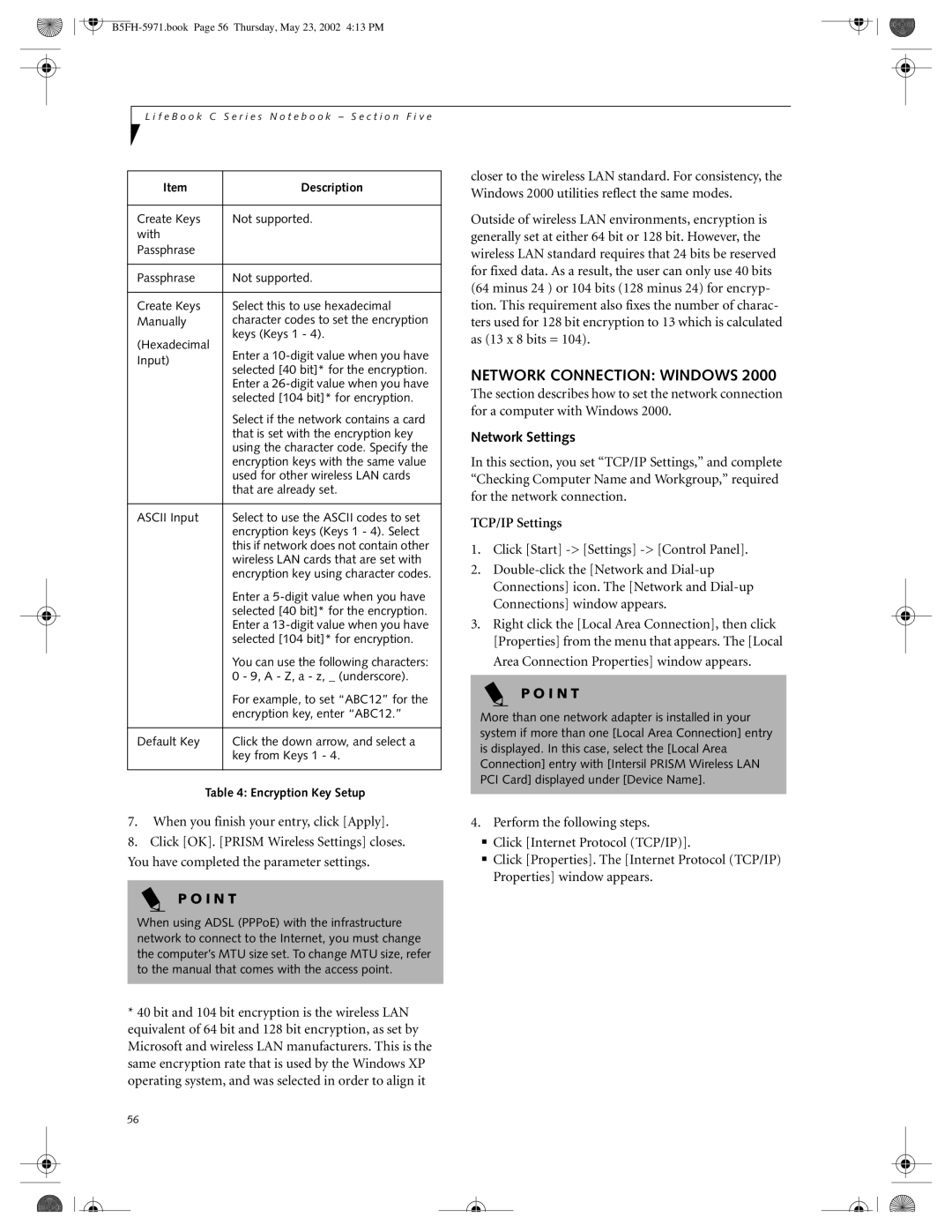
L i f e B o o k C S e r i e s N o t e b o o k – S e c t i o n F i v e
Item | Description | |
|
| |
Create Keys | Not supported. | |
with |
| |
Passphrase |
| |
|
| |
Passphrase | Not supported. | |
|
| |
Create Keys | Select this to use hexadecimal | |
Manually | character codes to set the encryption | |
(Hexadecimal | keys (Keys 1 - 4). | |
Enter a | ||
Input) | ||
selected [40 bit]* for the encryption. | ||
| ||
| Enter a | |
| selected [104 bit]* for encryption. | |
| Select if the network contains a card | |
| that is set with the encryption key | |
| using the character code. Specify the | |
| encryption keys with the same value | |
| used for other wireless LAN cards | |
| that are already set. | |
|
| |
ASCII Input | Select to use the ASCII codes to set | |
| encryption keys (Keys 1 - 4). Select | |
| this if network does not contain other | |
| wireless LAN cards that are set with | |
| encryption key using character codes. | |
| Enter a | |
| selected [40 bit]* for the encryption. | |
| Enter a | |
| selected [104 bit]* for encryption. | |
| You can use the following characters: | |
| 0 - 9, A - Z, a - z, _ (underscore). | |
| For example, to set “ABC12” for the | |
| encryption key, enter “ABC12.” | |
|
| |
Default Key | Click the down arrow, and select a | |
| key from Keys 1 - 4. | |
|
|
Table 4: Encryption Key Setup
7.When you finish your entry, click [Apply].
8.Click [OK]. [PRISM Wireless Settings] closes. You have completed the parameter settings.
P O I N T
When using ADSL (PPPoE) with the infrastructure network to connect to the Internet, you must change the computer’s MTU size set. To change MTU size, refer to the manual that comes with the access point.
*40 bit and 104 bit encryption is the wireless LAN equivalent of 64 bit and 128 bit encryption, as set by Microsoft and wireless LAN manufacturers. This is the same encryption rate that is used by the Windows XP operating system, and was selected in order to align it
closer to the wireless LAN standard. For consistency, the Windows 2000 utilities reflect the same modes.
Outside of wireless LAN environments, encryption is generally set at either 64 bit or 128 bit. However, the wireless LAN standard requires that 24 bits be reserved for fixed data. As a result, the user can only use 40 bits (64 minus 24 ) or 104 bits (128 minus 24) for encryp- tion. This requirement also fixes the number of charac- ters used for 128 bit encryption to 13 which is calculated as (13 x 8 bits = 104).
NETWORK CONNECTION: WINDOWS 2000
The section describes how to set the network connection for a computer with Windows 2000.
Network Settings
In this section, you set “TCP/IP Settings,” and complete “Checking Computer Name and Workgroup,” required for the network connection.
TCP/IP Settings
1.Click [Start]
2.
3.Right click the [Local Area Connection], then click [Properties] from the menu that appears. The [Local Area Connection Properties] window appears.
P O I N T
More than one network adapter is installed in your system if more than one [Local Area Connection] entry is displayed. In this case, select the [Local Area Connection] entry with [Intersil PRISM Wireless LAN PCI Card] displayed under [Device Name].
4.Perform the following steps.
■Click [Internet Protocol (TCP/IP)].
■Click [Properties]. The [Internet Protocol (TCP/IP) Properties] window appears.
56
